- Home
- News
- De Jonghe, tuin & aannemingen in Eeklo, Belgium: landscaping projects small and large, private and public
De Jonghe, tuin & aannemingen in Eeklo, Belgium: landscaping projects small and large, private and public
28/09/2023 - 15:23
This week we visited De Jonghe tuin & aannemingen in Eeklo, Belgium. A family business, which has more than 40 years of activity. The garden and contracting company has grown into a recognised player in the construction and maintenance of gardens of all shapes and sizes.
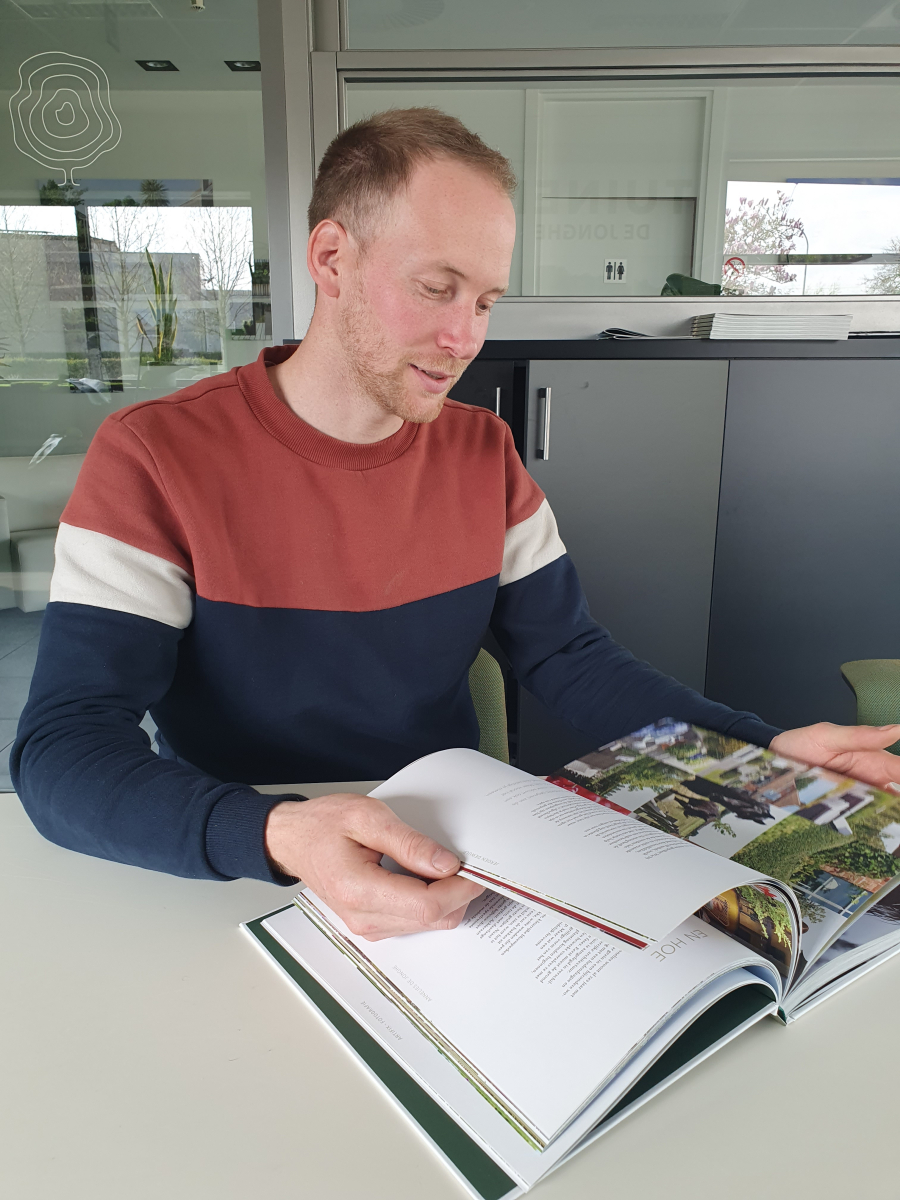 |
We spoke to Elias De Witte, landscape architect. He is the site manager for green projects. |
Hi Elias. Thanks for receiving us. I saw that De Jonghe BV has been around for more than 40 years: how long have you been working at the firm?
Eight years now. I got "stuck" here after my internship (laughs).
Where and what exactly did you study?
I studied landscape and garden architecture at HoGent, at Bijloke.
Coincidentally, I recently spoke with Niels Vandevelde who also studied there (read the interview here shortly)!
Niels?! He's from my year! We studied together. I know him very well: it’s a small world (laughs).
Why did you choose those studies?
Because greenery in general always appealed to me. I was always outside: romping around, climbing trees, …
In secondary school I did Economics - Modern Languages, but I didn't feel like continuing in that direction. It didn't appeal to me to be constantly stuck between four walls professionally.
"The nice thing about my job is the variation. I get to be outside a lot and am in contact with many people. I see the evolution of a project: from a line on paper to the building site and finally the end-result."
And the job is also very challenging and diverse. In fact, you have to know a little bit of everything. From whitewashing walls, to flooring terraces, to laying utility lines. And a lot about plants.
So where do you get all this knowledge?
Through studies and further education. But mainly via suppliers. And obviously through practical experience: what works and what doesn't.
You really have to keep up to date: to stand still is going backwards (laughs).
How do people find out about De Jonghe?
We put a lot of effort into marketing and social media (Facebook en Instagram).
Also still in the "old fashioned way", e.g. via the regional paper or De Zondag. It still generates requests. For instance, we published an article about Drainjet and a lot of requests for quotations came out of that.
But mainly through the work we do, through word-of-mouth advertising.
Do you know TerraCottem?
Yes we do. We use the soil conditioner regularly in roof gardens. The substrates used there drain tremendously. Which is good. But on the other hand, they don't hold much water.
"You can work with drip irrigation and the like, but TerraCottem is a better solution for us. It provides more water retention and moisture is plant available for a longer period of time."
Are more roof gardens being built now than in the past?
Actually, yes. Not only private roof gardens, but also on a larger scale. In Temse, for instance, a few residential towers were built along the river Scheldt. Under these residential towers a large underground car park was built with a 4000 m2 podium garden on top. The soil profile is only 50-60cm deep. We mixed TerraCottem into the topsoil to increase water retention.
Who decides to use certain soil conditioners?
In this case, in Temse, we included it in the specifications. The final decision remains with the client, but we can usually convince them quite easily. We make sure that the measurement sheet always includes sufficient information about the products as an extra argumentation.
You said "quite easily"?
In fact, yes. It used to be more about cost: that was the all-important factor. But nowadays, more attention is paid to "greenery" in general. Especially in public spaces. For instance, much more attention is paid to the location of trees: suitable tree species, optimal substrate, soil improvement, etc.
Aftercare is also very important. Especially with climate change and drought.
After all, planting a tree represents a considerable capital. Whereas before small trees of the size of 16/18 or 10/12 used to be planted, nowadays bigger sized trees are being planted. If such an investment is made, it is logical that the final location of the trees should be optimal.
"The extra investment in soil conditioning generally does not weigh up on the total cost."
Do you carry the responsibility for the successful establishment of plants?
For public projects, there is always a planting guarantee. We are usually responsible for the plants for 3 years: we do the maintenance and replace any dead plants.
For other projects, we tend to work with an annual guarantee. For example, we planted about 100 trees at an allotment in Waarschot. The soil was far from ideal. There were also a lot of utility lines. There was some tree loss and we replaced the dead trees.
On the private market, we no longer provide a guarantee. On the one hand, because we cannot always take care of maintenance ourselves. On the other hand, we don't know how clients handle their plants. But we do share our knowledge: we send maintenance sheets, for instance. This gives people a guide to get started. We developed these because there was a lot of demand for them.
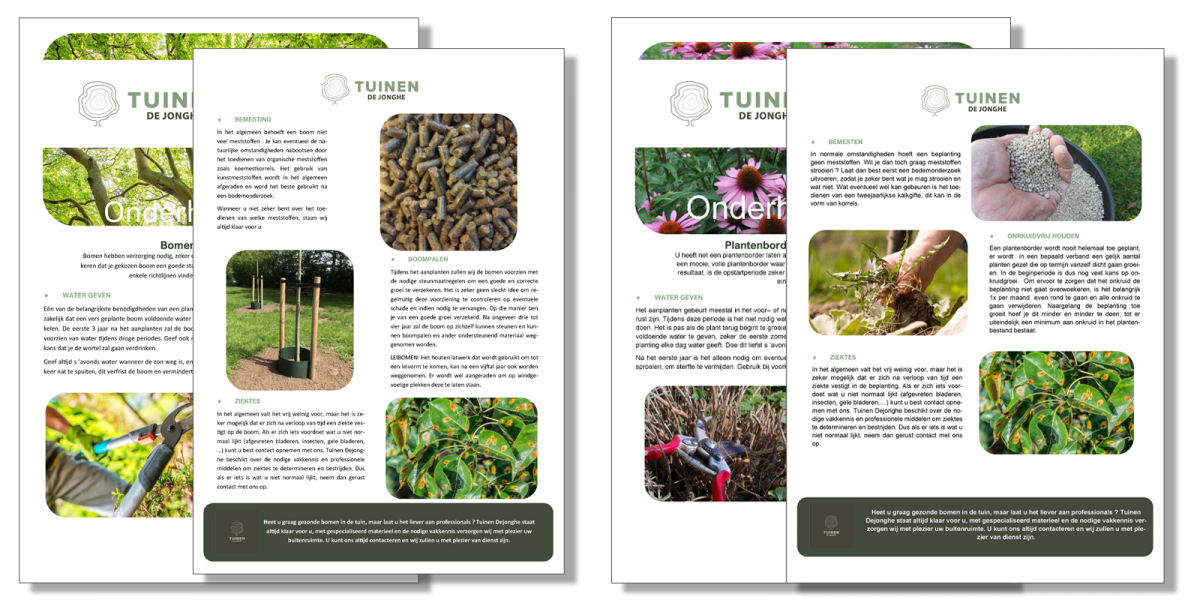
How many projects do you do on an annual basis?
In terms of plantings? About 50-60 projects, both small and large. Private and public.
How many people work at De Jonghe?
Some 60 in total. 4 landscapers: Annelies (the owner), Steffen, Günther and myself.
A number of colleagues do the administration. We also have road workers and green workers. And finally, a number of industrial maintenance crews.

Annelies and Steffen draw the plans. These then come to me for quotation. If there is subsequent approval for execution, the plans come back to me to then follow up the project.
| About De Jonge BVBA | |
|---|---|
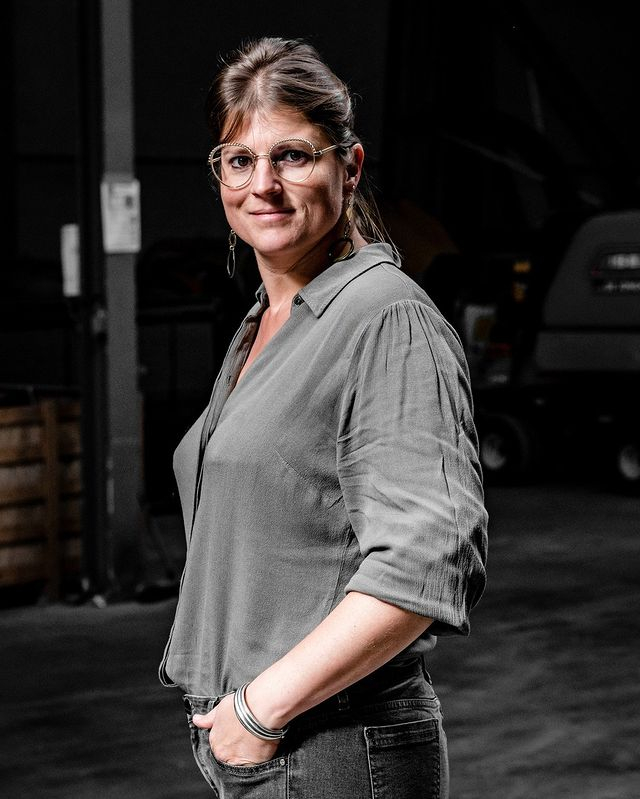 |
De Jonghe Tuin & Aannemingen was founded in 1976 by Achiel De Jonghe and his wife Antoinette. Daughter Annelies followed in her father's footsteps in 2000, just after graduating. She took over the family business in 2019. Besides day-to-day management, Annelies still designs the most beautiful landscape and urban gardens. All digitally. |
In fact, that is the most fun: starting from our own design. With public works, the preliminary study has usually already been done by a design agency: we have to stick to that. We can give input, though, for example if no TerraCottem is prescribed and we feel the need for it. Then approval needs to be obtained. For our own projects, we immediately put everything in the quote. For tree planting, for instance, we provide standard fertilisers and soil conditioning.
Coming back to Drainjet for a moment. Can you tell me a bit more about it?
We bought our own vertical draining device through Robin Useel of Arbo Art. We use Drainjet to break up disturbing layers and do injections, which we did, for example, at the park cemetery in Assenede:
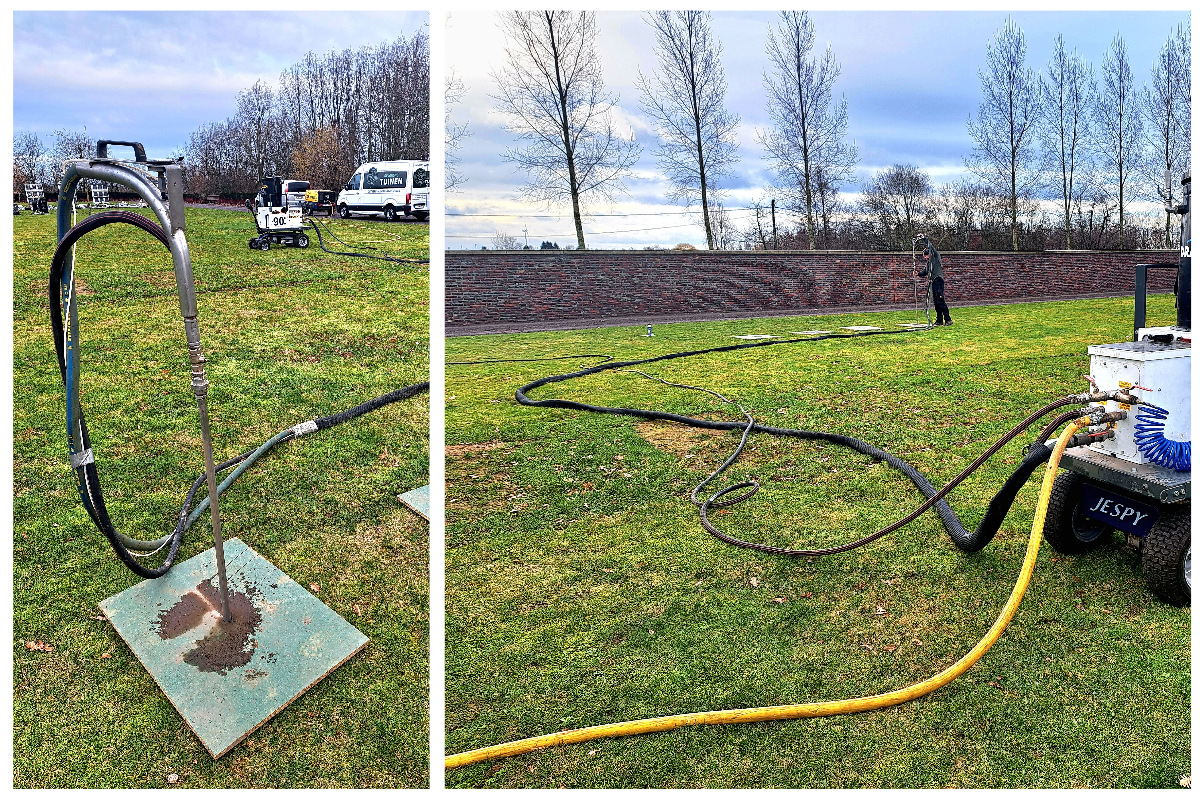
"Here on our own property, there are some espalier trees, Acer campestre, one of which was struggling for years. We injected it with lava and TerraCottem: now it is doing very well."
| Read some interesting articles about the Drainjet here: |
|---|
Discover the different ways to plant trees with TerraCottem:
|
Do you have a project you would like to highlight?
Yes, I do have a few....
In Eeklo, we did the central reservation of Molenstraat, a busy road right in the centre. Between the double lanes on both sides is a green strip. A project with a long history. First this was a grass strip. But then it was decided to turn it into a green zone with perennials, shrubs and trees.
The first time, the planting had completely failed, not because of us (laughs), partly because of the wrong choice of plants. Shade plants were planted when there wasn't enough shade because the trees that were supposed to provide it were much too small.
We replanted in autumn '22, with more drought-resistant plants such as Artemisia, Calamintha, Asters, Euphorbia, Nepeta, Sedum, Origanum, Salvia, Perovskia, Stachys and Saporina. And each plant got its dose of TerraCottem: a total of 440kg of soil conditioner was incorporated.
The plants suffer a lot at that location. Because of the wind, but also because of the passage of numerous cars and the de-icing salts in winter. Sometimes, also by people treading.
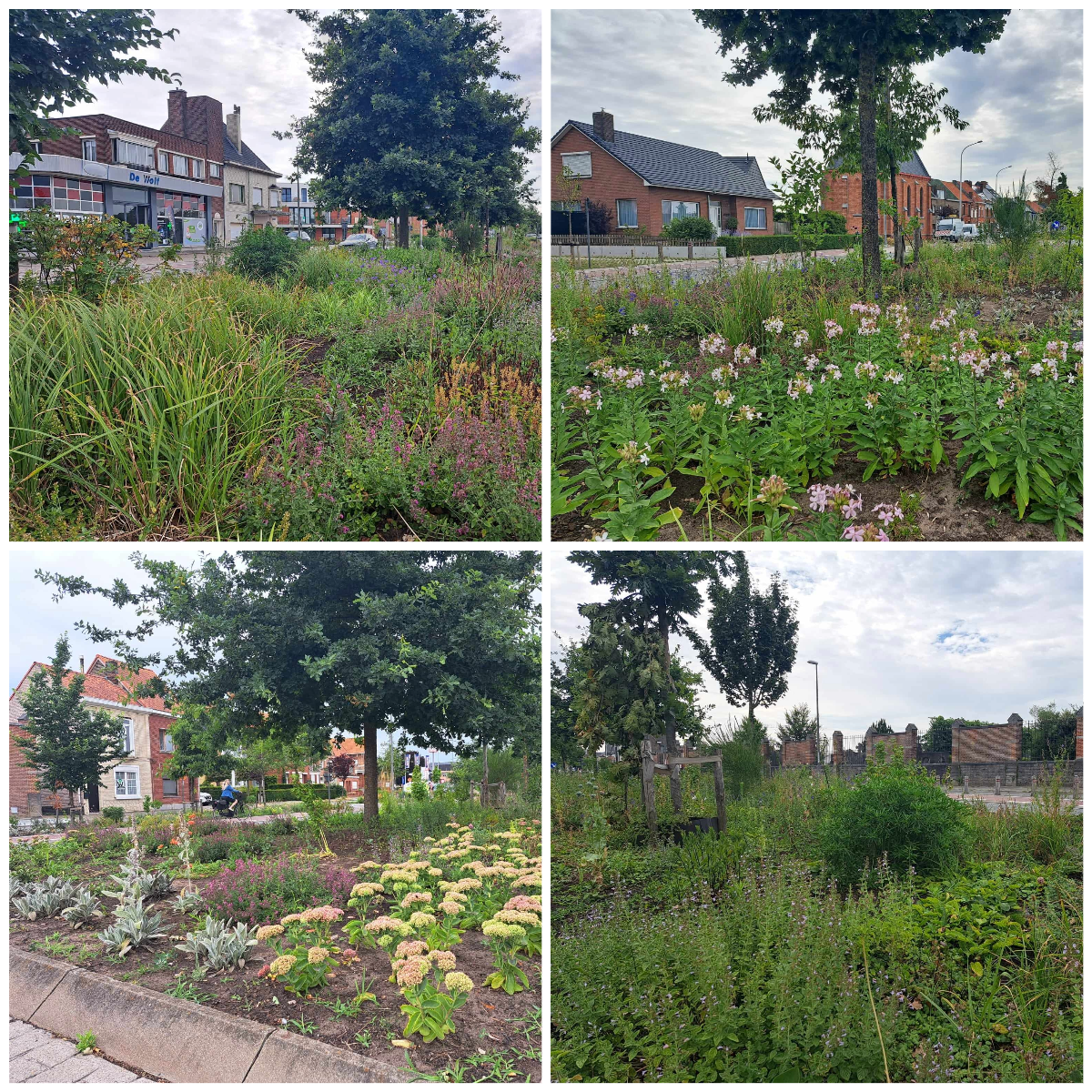
A fun project was the design of the terrace of the oncology department at university hospital Maria Mediatrix in Ghent. The aim was twofold:
- Privacy had to be created towards the rooms.
- The terrace had to be made cosy so that the therapists could go outside with the patients for a break or a chat.
It is also interesting to note that part of the garden was paid for with sponsorship money.
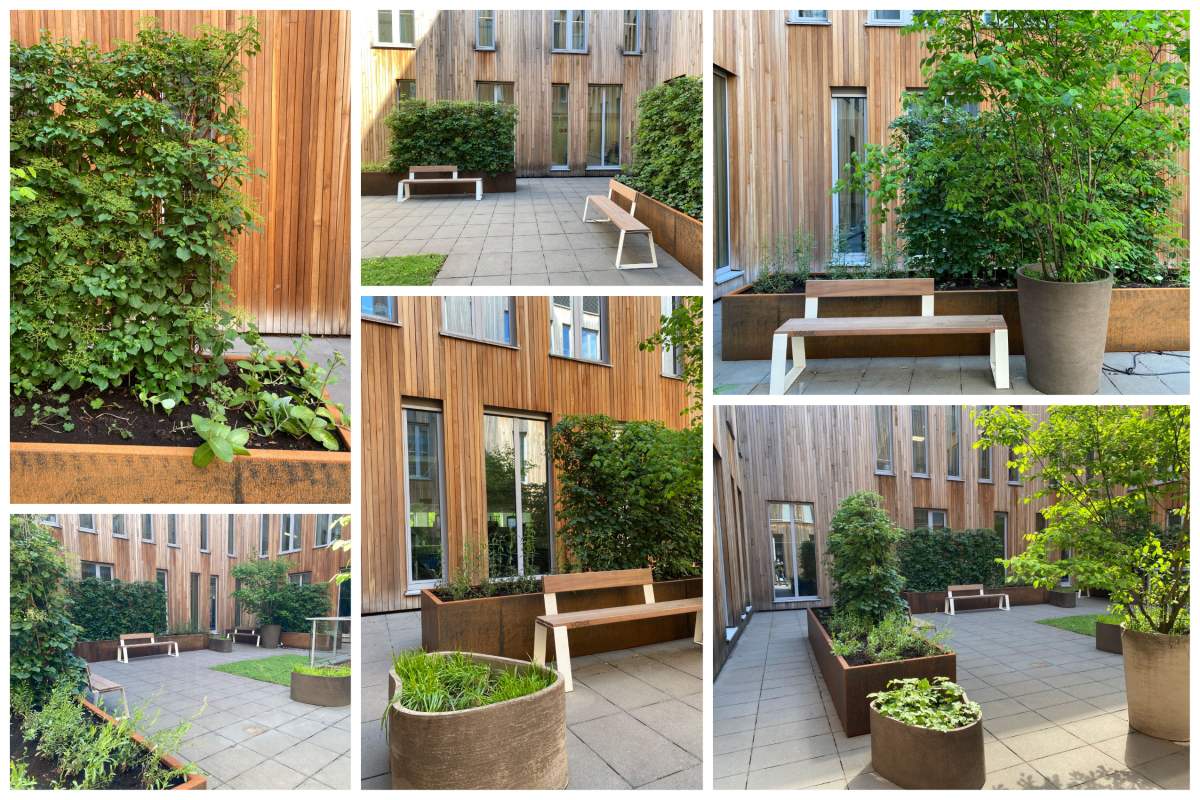
Do you have favourite plants, plants that often recur in projects?
We try to avoid working with the same plants all the time so as not to limit originality.
But in prairie gardens, for example, I like to work with coneflower (Echinacea). A very rewarding plant. I think it should always be included. It is not only liked by the clients, but also by bees and butterflies. A beautiful plant, which flowers for a very long time. Until deep into late summer. And it comes in lots of shades of colour, and in all shapes. Stunning in borders.

We also increasingly look for more drought-resistant plants. Especially here in our region, where there is a lot of sandy soil. To limit failure. A nice species here is the falling star (Crocosmia). A bulbous plant, with an "exotic" feel.

In terms of trees, I don't really have a preference. There are so many of them. All have some added value.
Thank you for the very nice chat, Elias. Good luck with your future projects!
More information about De Jonghe tuin & aannemingen?
DE JONGHE BVBA
Nieuwendorpe 49
9900 Eeklo
T: 09 344 45 45
Instagram: @dejonghetuinen
Facebook: dejonghetuinaannemingen
If you know someone who would also like to read this article, feel free to copy the link and share.
Would you like to be in the spotlight too?
You can!
Send a quick email to marketing@terracottem.be and we will schedule an online meeting together.
Would you also like to use TerraCottem in your projects?
Contact usWould you also like to use TerraCottem in your projects?
Contact usTerraCottem Intl. SL
Apartado de Correos 4511190 Benalup (Cádiz)Spain

